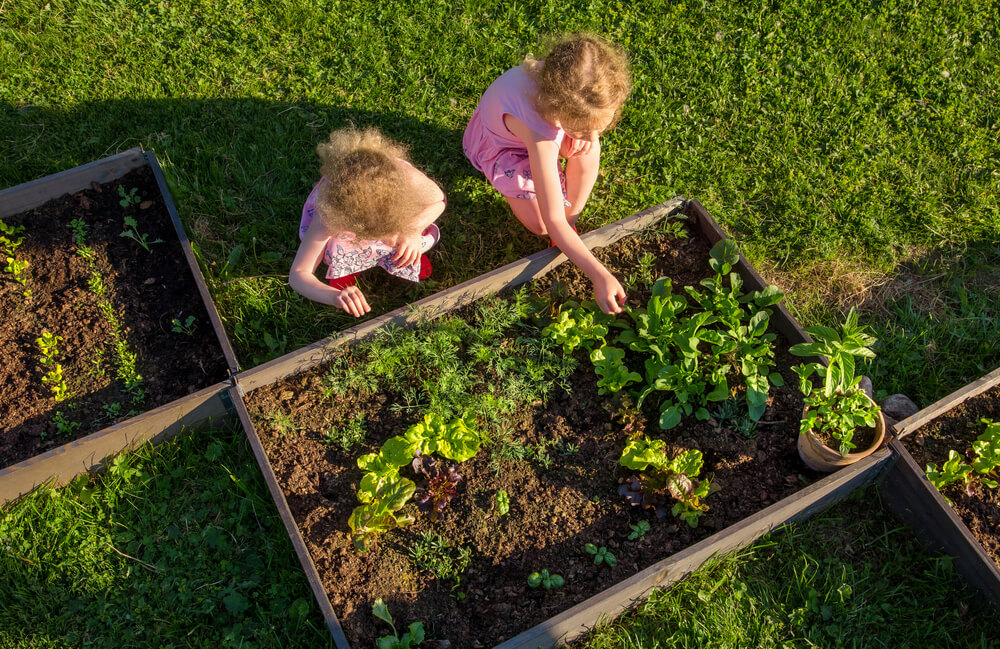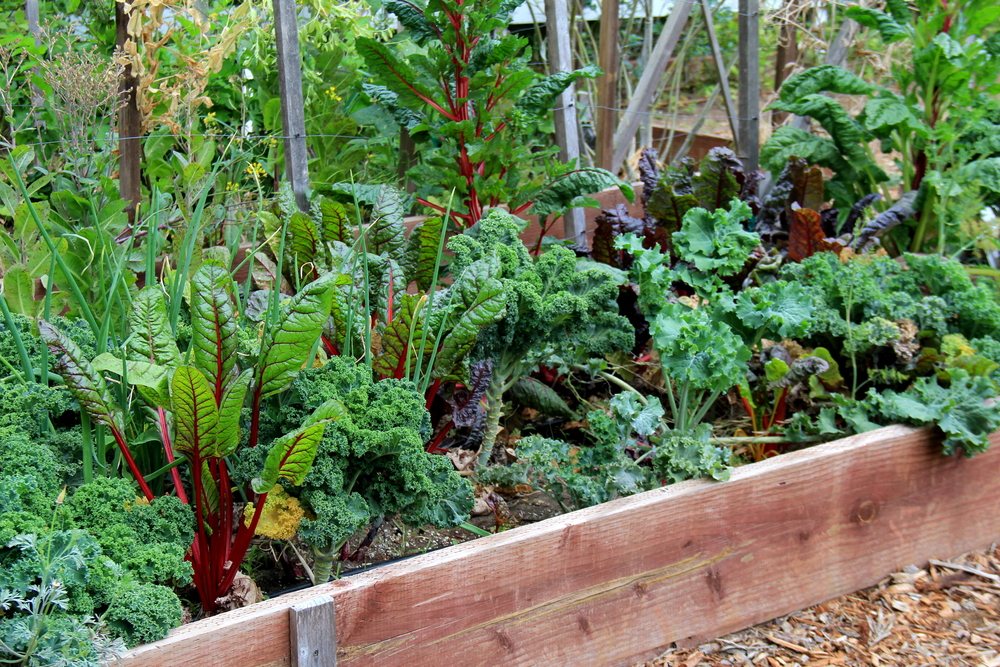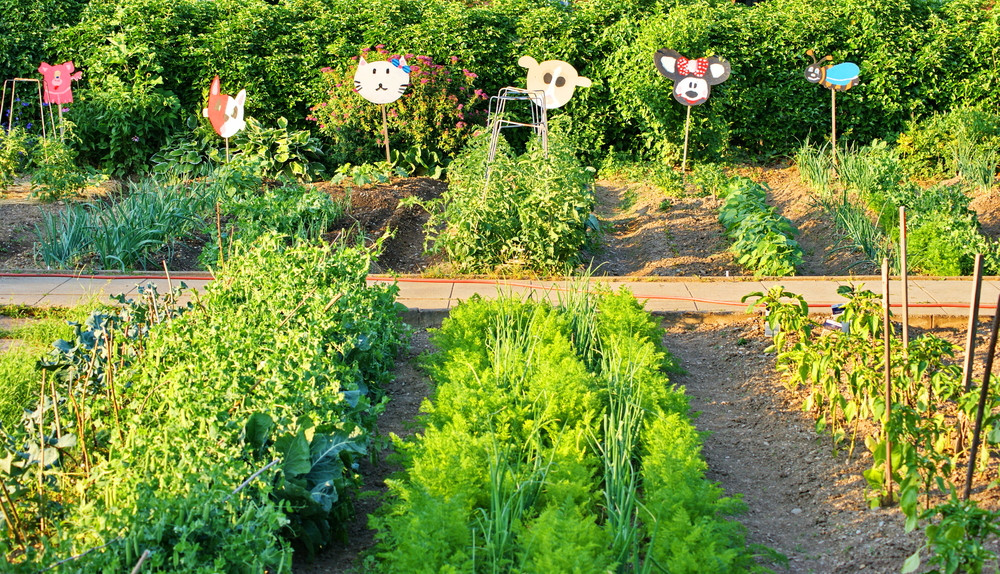Opinion: Community and School Gardens Don’t Magically Sprout Bountiful Benefits
Gardens require a huge amount of labor, and outcomes like health, well-being or food security are affected by systemic barriers people face in cities and schools.
Opinion: Community and School Gardens Don’t Magically Sprout Bountiful Benefits
Gardens require a huge amount of labor, and outcomes like health, well-being or food security are affected by systemic barriers people face in cities and schools.

Children pick lettuce at a community garden.by FotoHelin, Shutterstock.
This article is republished from The Conversation under a Creative Commons license. Read the original article.
While it is widely understood that community and and school gardening have innumerable health, well-being and educational benefits, it’s important to realize these benefits don’t magically appear when gardens take root.
Over the past six years, I’ve worked closely with educators, community workers, activists and community members in Tio’tia:ke/Montréal as we created, funded and sustained gardens and garden teams at schools and community organizations.
We set up adult education internships to provide practical gardening and teaching support to explore the extent to which gardens act as forums where people address social and environmental justice. Some participants experienced barriers to employment, food insecurity and homelessness.
This research and community work demonstrated how critical it is to advocate for broader social, urban and educational structural changes to support community garden work — and to understand the importance of having realistic expectations about what people can accomplish in and through gardens.
Who do benefits reach?
In Tio’tia:ke/Montréal, community gardening unfolds in many different ways that might include gardening efforts at community-based organizations and city-run gardens.
There are significant wait lists to access a garden plot in the city, exacerbated by community gardens being historically reserved for property-owning individuals.
According to the mayor of Montréal, “for many people, community gardens are more than just a hobby. They allow them to feed their families and to obtain fresh produce at a low cost.”
Such statements obscure more complex issues around who controls and accesses community gardens and deeper entrenched social inequities relating to land rights in a capitalist settler-colonial society that privileges ownership, whiteness and hierarchical modes of relating.

Relationship to food insecurity
My findings contest claims that suggest community gardening is inherently an activity that reduces under-served communities’ food insecurity.
Reflecting on my efforts to grow food for organizations that work with people experiencing food insecurity, as part of a project called “Gardening for Food Security,” I cannot claim gardening helped to alleviate the concerns of people experiencing food insecurity in any quantifiable way.
This is despite producing an immense amount of food harvested on a weekly/bi-weekly basis from late June to early November in 2018 and 2019.
Although the gardens were thriving, the organization never reduced their food order to Montréal’s largest food bank. This may be because while participants ate from the garden harvest, their reliance upon it did not reduce their need for other food. The Gardening for Food Security project did, however, modestly support a food bank and a once-a-week meal service.
Mixed effects for communities, individuals
As we gardened and invested in gardens for different social, educational and environmental reasons in rapidly gentrifying neighborhoods, we contributed to increasing land values in a process described as green gentrification.
Despite these critical observations, some benefits of the project included:
—offering relevant paid employment for young adults experiencing barriers to employment, food insecurity and homelessness;
—providing mentorship and opportunities for under-served young adults and students to express themselves (through art, photography, music, film, gardening);
—facilitating partnerships between schools and organizations with mandates of social and environmental justice for mutual benefit;
—acquiring prolonged financial, learning and human resource support to educators, learners, community workers and community members, while developing ethical relationships and collaborating to accomplish shared objectives.
The latter three types of benefits are difficult to quantify to funders.

Problems with schools gardens
Gardening as part of environmental education is not mandatory core curriculum in Québec. School gardening often occurs outside of formal class time, during lunch hour or after school. Taken together, organizing gardening experiences for students within most public schools adds additional labour to already overworked and under-supported educators.
For gardening to be relevant and add educational value for both teachers and learners, gardens need to be incorporated into each core curricular area (French, English, Math and so on) and not only used before or after school hours and during lunchtime.
Many of my teacher collaborators stated that they are fully committed and interested in creating garden-based learning experiences for their students. But securing permissions translates to administrative labour. This can detract from arranging other important aspects of garden creation like establishing funding, building relationships with collaborators or drawing curricular connections and so on.
Small community change
Tio’tia:ke/Montréal, like many Canadian cities, has a long winter and a short intense summer. For school gardens to work, the planning and administrative labour and permissions for a spring garden need to happen early in the school year to account for inevitable delays.
If educators or outside parties wish to support school gardens with funding and labour, I strongly recommend that students lead the creation, development and importantly the evaluation of the garden as a project.
When gardens are prematurely celebrated for producing anticipated outcomes such as health and well-being and food security, without a larger acknowledgement of how these complex issues are affected by systemic barriers, much can be lost.
This includes the well-being of teachers who invest immense labour in something they believe in with limited institutional support, and affordable spaces for people to live who get dispossessed of their homes, communities and networks through green gentrification.
No easy solutions
There are no easy solutions to the social and environmental problems of school, community gardening or greening.
Often, teachers and community members want and need a garden, but they are more in need of: financial support, teaching support, human resource support, more time, fewer students, curricular freedom, relevant professional development and land that isn’t part of a bigger capitalist system of private ownership or tied up in red tape.
Even small community change takes time and needs ongoing collective effort.
Mitchell McLarnon is an assistant professor of adult education at Concordia University.
Follow us
This work is licensed under a Creative Commons Attribution-NoDerivatives 4.0 International License.
Want to republish a Modern Farmer story?
We are happy for Modern Farmer stories to be shared, and encourage you to republish our articles for your audience. When doing so, we ask that you follow these guidelines:
Please credit us and our writers
For the author byline, please use “Author Name, Modern Farmer.” At the top of our stories, if on the web, please include this text and link: “This story was originally published by Modern Farmer.”
Please make sure to include a link back to either our home page or the article URL.
At the bottom of the story, please include the following text:
“Modern Farmer is a nonprofit initiative dedicated to raising awareness and catalyzing action at the intersection of food, agriculture, and society. Read more at <link>Modern Farmer</link>.”
Use our widget
We’d like to be able to track our stories, so we ask that if you republish our content, you do so using our widget (located on the left hand side of the article). The HTML code has a built-in tracker that tells us the data and domain where the story was published, as well as view counts.
Check the image requirements
It’s your responsibility to confirm you're licensed to republish images in our articles. Some images, such as those from commercial providers, don't allow their images to be republished without permission or payment. Copyright terms are generally listed in the image caption and attribution. You are welcome to omit our images or substitute with your own. Charts and interactive graphics follow the same rules.
Don’t change too much. Or, ask us first.
Articles must be republished in their entirety. It’s okay to change references to time (“today” to “yesterday”) or location (“Iowa City, IA” to “here”). But please keep everything else the same.
If you feel strongly that a more material edit needs to be made, get in touch with us at [email protected]. We’re happy to discuss it with the original author, but we must have prior approval for changes before publication.
Special cases
Extracts. You may run the first few lines or paragraphs of the article and then say: “Read the full article at Modern Farmer” with a link back to the original article.
Quotes. You may quote authors provided you include a link back to the article URL.
Translations. These require writer approval. To inquire about translation of a Modern Farmer article, contact us at [email protected]
Signed consent / copyright release forms. These are not required, provided you are following these guidelines.
Print. Articles can be republished in print under these same rules, with the exception that you do not need to include the links.
Tag us
When sharing the story on social media, please tag us using the following: - Twitter (@ModFarm) - Facebook (@ModernFarmerMedia) - Instagram (@modfarm)
Use our content respectfully
Modern Farmer is a nonprofit and as such we share our content for free and in good faith in order to reach new audiences. Respectfully,
No selling ads against our stories. It’s okay to put our stories on pages with ads.
Don’t republish our material wholesale, or automatically; you need to select stories to be republished individually.
You have no rights to sell, license, syndicate, or otherwise represent yourself as the authorized owner of our material to any third parties. This means that you cannot actively publish or submit our work for syndication to third party platforms or apps like Apple News or Google News. We understand that publishers cannot fully control when certain third parties automatically summarize or crawl content from publishers’ own sites.
Keep in touch
We want to hear from you if you love Modern Farmer content, have a collaboration idea, or anything else to share. As a nonprofit outlet, we work in service of our community and are always open to comments, feedback, and ideas. Contact us at [email protected].by Mitchell McLarnon, Modern Farmer
August 5, 2022
Modern Farmer Weekly
Solutions Hub
Innovations, ideas and inspiration. Actionable solutions for a resilient food system.
ExploreExplore other topics
Share With Us
We want to hear from Modern Farmer readers who have thoughtful commentary, actionable solutions, or helpful ideas to share.
SubmitNecessary cookies are absolutely essential for the website to function properly. This category only includes cookies that ensures basic functionalities and security features of the website. These cookies do not store any personal information.
Any cookies that may not be particularly necessary for the website to function and are used specifically to collect user personal data via analytics, ads, other embedded contents are termed as non-necessary cookies.
“For gardening to be relevant and add educational value for both teachers and learners, gardens need to be incorporated into each core curricular area (French, English, Math and so on)” How about incorporating school gardens into biology classes? Plant physiology, human physiology of taste and smell, plant root & soil interactions, flower & pollinator relationships…..If the world is to move to a more plant-forward diet, surely kids need to learn about plants.
Thanks! This is the first time I’ve seen practical, usable advice about school gardens rather than just hype that sounds like advertising copy.